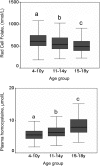Biomarkers of Nutrition for Development-Folate Review
- PMID: 26451605
- PMCID: PMC4478945
- DOI: 10.3945/jn.114.206599
Biomarkers of Nutrition for Development-Folate Review
Abstract
The Biomarkers of Nutrition for Development (BOND) project is designed to provide evidence-based advice to anyone with an interest in the role of nutrition in health. Specifically, the BOND program provides state-of-the-art information and service with regard to selection, use, and interpretation of biomarkers of nutrient exposure, status, function, and effect. To accomplish this objective, expert panels are recruited to evaluate the literature and to draft comprehensive reports on the current state of the art with regard to specific nutrient biology and available biomarkers for assessing nutrients in body tissues at the individual and population level. Phase I of the BOND project includes the evaluation of biomarkers for 6 nutrients: iodine, iron, zinc, folate, vitamin A, and vitamin B-12. This review represents the second in the series of reviews and covers all relevant aspects of folate biology and biomarkers. The article is organized to provide the reader with a full appreciation of folate's history as a public health issue, its biology, and an overview of available biomarkers (serum folate, RBC folate, and plasma homocysteine concentrations) and their interpretation across a range of clinical and population-based uses. The article also includes a list of priority research needs for advancing the area of folate biomarkers related to nutritional health status and development.
Keywords: BOND; RBC folate; folate biomarkers; homocysteine; serum folate.
© 2015 American Society for Nutrition.
Conflict of interest statement
Author disclosures: LB Bailey, PJ Stover, H McNulty, MF Fenech, JF Gregory III, JL Mills, CM Pfeiffer, Z Fazili, M Zhang, PM Ueland, AM Molloy, MA Caudill, B Shane, RJ Berry, RL Bailey, DB Hausman, R Raghavan, and DJ Raiten, no conflicts of interest.
Figures











Similar articles
-
Biomarkers of Nutrition for Development (BOND)-Vitamin A Review.J Nutr. 2016 Sep;146(9):1816S-48S. doi: 10.3945/jn.115.229708. Epub 2016 Aug 10. J Nutr. 2016. PMID: 27511929 Free PMC article. Review.
-
Folic acid supplementation and malaria susceptibility and severity among people taking antifolate antimalarial drugs in endemic areas.Cochrane Database Syst Rev. 2022 Feb 1;2(2022):CD014217. doi: 10.1002/14651858.CD014217. Cochrane Database Syst Rev. 2022. PMID: 36321557 Free PMC article.
-
Biomarkers of nutrition for development--iodine review.J Nutr. 2014 Aug;144(8):1322S-1342S. doi: 10.3945/jn.113.181974. Epub 2014 Jun 25. J Nutr. 2014. PMID: 24966410 Free PMC article. Review.
-
Impact of voluntary fortification and supplement use on dietary intakes and biomarker status of folate and vitamin B-12 in Irish adults.Am J Clin Nutr. 2015 Jun;101(6):1163-72. doi: 10.3945/ajcn.115.107151. Epub 2015 Apr 15. Am J Clin Nutr. 2015. PMID: 25877491
-
Biomarkers of Nutrition for Development (BOND): Vitamin B-12 Review.J Nutr. 2018 Dec 1;148(suppl_4):1995S-2027S. doi: 10.1093/jn/nxy201. J Nutr. 2018. PMID: 30500928 Free PMC article. Review.
Cited by
-
Folic Acid as a Potential Vitamin in Glycemic Control: A Systematic Review.Curr Nutr Rep. 2024 Dec;13(4):729-750. doi: 10.1007/s13668-024-00565-5. Epub 2024 Sep 10. Curr Nutr Rep. 2024. PMID: 39251542
-
Revitalising Riboflavin: Unveiling Its Timeless Significance in Human Physiology and Health.Foods. 2024 Jul 17;13(14):2255. doi: 10.3390/foods13142255. Foods. 2024. PMID: 39063339 Free PMC article. Review.
-
Interactions between folate intake and genetic predictors of gene expression levels associated with colorectal cancer risk.Sci Rep. 2022 Nov 7;12(1):18852. doi: 10.1038/s41598-022-23451-y. Sci Rep. 2022. PMID: 36344807 Free PMC article.
-
Perspective: Nutritional Status as a Biological Variable (NABV): Integrating Nutrition Science into Basic and Clinical Research and Care.Adv Nutr. 2021 Oct 1;12(5):1599-1609. doi: 10.1093/advances/nmab046. Adv Nutr. 2021. PMID: 34009250 Free PMC article.
-
Demographic, Physiologic, and Lifestyle Characteristics Observed with Serum Total Folate Differ Among Folate Forms: Cross-Sectional Data from Fasting Samples in the NHANES 2011-2016.J Nutr. 2020 Apr 1;150(4):851-860. doi: 10.1093/jn/nxz278. J Nutr. 2020. PMID: 31875475 Free PMC article.
References
-
- Wills L. Treatment of "pernicious anaemia of pregnancy" and "tropical anaemia" with special reference to yeast extract as a curative agent. BMJ 1931;1:1059–64. - PubMed
-
- Mitchell HK, Snell EE, Williams RJ. Journal of the American Chemical Society, vol. 63, 1941: the concentration of "folic acid" by Herschel K. Mitchell, Esmond E. Snell, and Roger J. Williams. Nutr Rev 1988;46:324–5. - PubMed
-
- Spies TD. Treatment of macrocytic anaemia with folic acid. Lancet 1946;250: 225–8. - PubMed
-
- Molloy AM, Daly S, Mills JL, Kirke PN, Whitehead AS, Ramsbottom D, Conley MR, Weir DG, Scott JM. Thermolabile variant of 5,10-methylenetetrahydrofolate reductase associated with low red-cell folates: implications for folate intake recommendations. Lancet 1997;349:1591–3. - PubMed
Publication types
MeSH terms
Substances
LinkOut - more resources
Full Text Sources
Other Literature Sources
Medical

